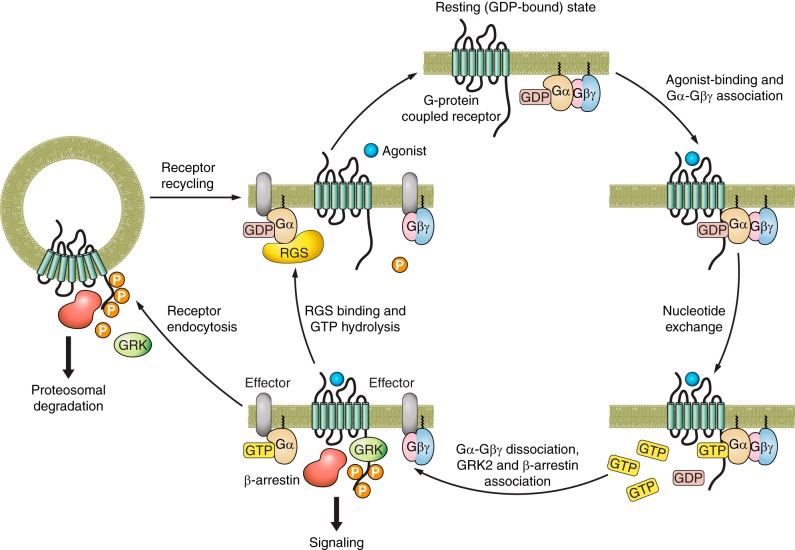Introduction of GPR176
GPR176 belongs to the G-protein-coupled receptor (GPCR) family which contains important regulators of various cellular functions via activation of intracellular signaling events. GPR176 is an evolutionally conserved, vertebrate class A orphan GPCR. Amino-acid sequence analysis reveals that GPR176 contains four putative glycosylation sites at the N-terminal part. A relatively large, C-terminal domain of about 200 amino acids also characterizes GPR176.
| Basic Information of GPR176 | |
| Protein Name | G-protein coupled receptor 176 |
| Gene Name | GPR176 |
| Aliases | HB-954 |
| Organism | Homo sapiens (Human) |
| UniProt ID | Q14439 |
| Transmembrane Times | 7 |
| Length (aa) | 515 |
| Sequence | MGHNGSWISPNASEPHNASGAEAAGVNRSALGEFGEAQLYRQFTTTVQVVIFIGSLLGNFMVLWSTCRTTVFKSVTNRFIKNLACSGICASLVCVPFDIILSTSPHCCWWIYTMLFCKVVKFLHKVFCSVTILSFPAIALDRYYSVLYPLERKISDAKSRELVMYIWAHAVVASVPVFAVTNVADIYATSTCTEVWSNSLGHLVYVLVYNITTVIVPVVVVFLFLILIRRALSASQKKKVIIAALRTPQNTISIPYASQREAELHATLLSMVMVFILCSVPYATLVVYQTVLNVPDTSVFLLLTAVWLPKVSLLANPVLFLTVNKSVRKCLIGTLVQLHHRYSRRNVVSTGSGMAEASLEPSIRSGSQLLEMFHIGQQQIFKPTEDEEESEAKYIGSADFQAKEIFSTCLEGEQGPQFAPSAPPLSTVDSVSQVAPAAPVEPETFPDKYSLQFGFGPFELPPQWLSETRNSKKRLLPPLGNTPEELIQTKVPKVGRVERKMSRNNKVSIFPKVDS |
Function of GPR176 Membrane Protein
GPR176 is mainly expressed in the brain, with prominent expression in the suprachiasmatic nucleus (SCN), and its protein abundance fluctuates in a circadian fashion. GPR176 is identified as an SCN-enriched orphan GPCR that sets the pace of circadian behavior. GPR176 is expressed in a circadian manner by SCN neurons. Molecular characterization further revealed that this orphan receptor has an agonist-independent basal activity to repress cAMP production. Besides, GPR176 acts independently of, and in parallel to, the Vipr2 GPCR, not through the canonical Gi, but via the unique G-protein subclass Gz, which is a unique Gi/G0 subfamily member that can repress adenylyl cyclases in a PTX-insensitive manner, and its expression is known to be high particularly in the brain and in several specific tissues or cells in the periphery. GPR176/Gz is a new signaling module in the control of SCN circadian time-keeping, it provides a new class of GPCR signaling as a potential drug target to modulate the central clock in the brain.
 Fig.1 G protein-coupled receptor activation and reactivation. (Sato, 2014)
Fig.1 G protein-coupled receptor activation and reactivation. (Sato, 2014)
Application of GPR176 Membrane Protein in Literature
This article reviews a recently identified role of GPR176 in the SCN. GPR176 is an SCN-enriched orphan GPCR that sets the pace of the circadian clock in the SCN. GPR176 has an agonist-independent basal activity to reduce cAMP signaling. A unique cAMP-repressing G-protein subclass Gz is required for the activity of GPR176.
This article identifies GPR176 as an SCN-enriched orphan GPCR that sets the pace of circadian behavior. GPR176 is expressed in a circadian manner by SCN neurons, and molecular characterization reveals that it represses cAMP signaling in an agonist-independent manner.
Authors in this group find that GPR176 is altered by Anacardic acid, which is a potential dietary agent for preventing and treating breast cancer, inhibited the proliferation of estrogen receptor α (ERα) positive MCF-7 and MDA-MB-231 triple negative breast cancer cells.
GPR176 Preparation Options
To obtain the soluble and functional target protein, the versatile Magic™ membrane protein production platform in Creative Biolabs enables many flexible options, from which you can always find a better match for your particular project. Aided by our versatile Magic™ anti-membrane protein antibody discovery platform, we also provide customized anti-GPR176 antibody development services.
As a forward-looking research institute as well as a leading customer service provider in the field of membrane protein, Creative Biolabs has won good reputation among our worldwide customers for successfully accomplishing numerous challenging projects including generation of many functional membrane proteins. Please feel free to contact us for more information.
Reference
All listed services and products are For Research Use Only. Do Not use in any diagnostic or therapeutic applications.